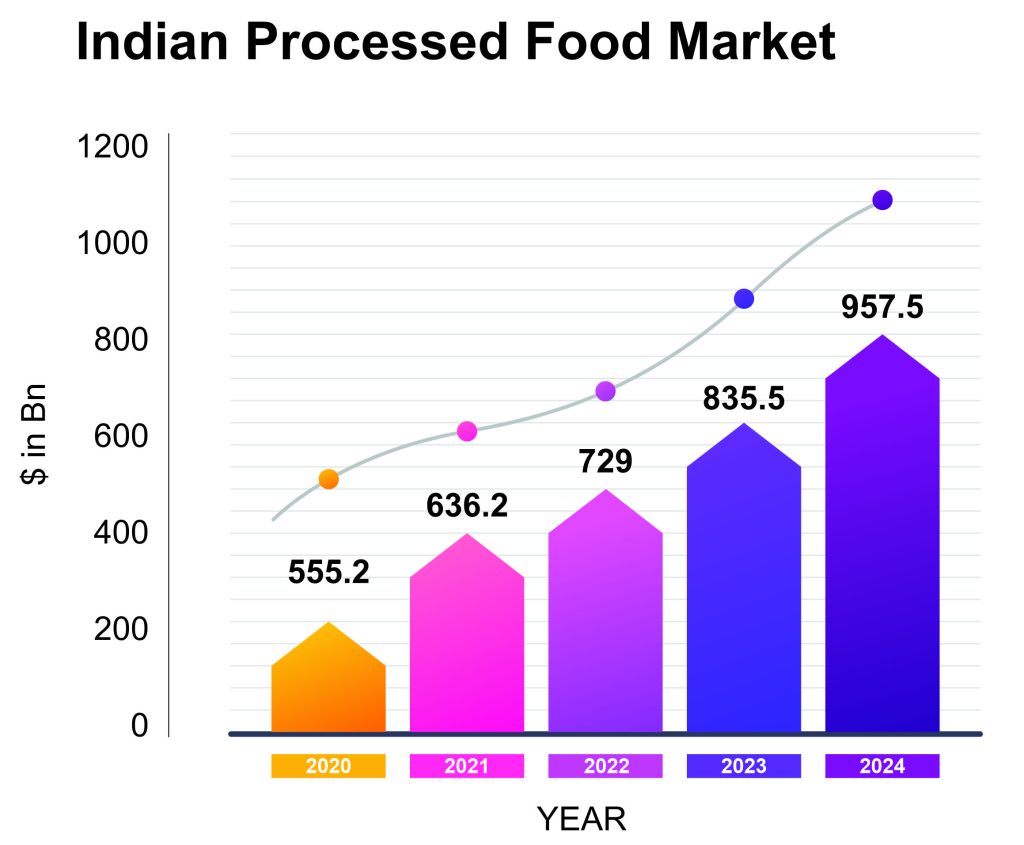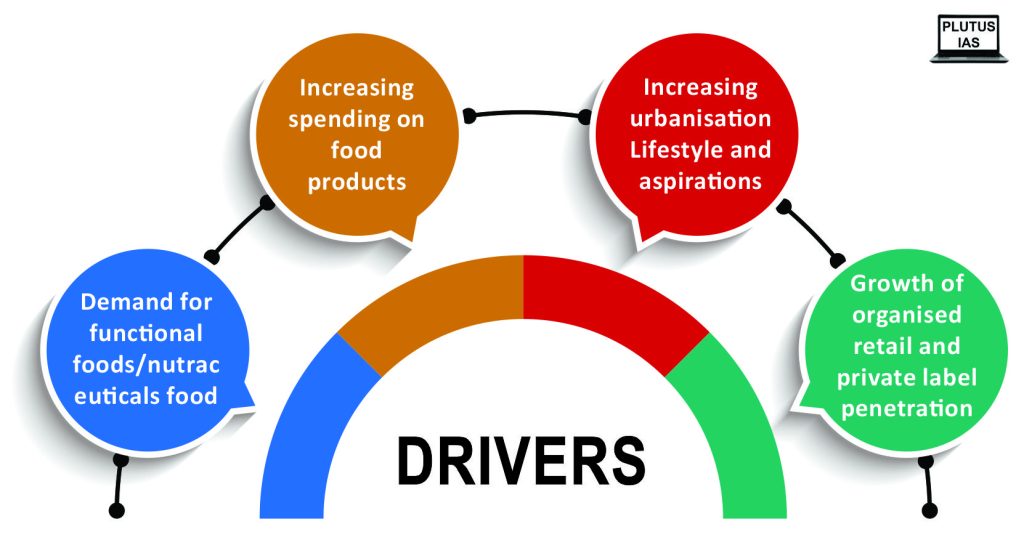13 Jan Food Processing Industries
This article covers ‘Daily Current Affairs’ and the topic details of “Growth in the Food processing sector ’’. This topic is relevant in the “Indian Economy” section of the UPSC CSE exam.
UPSC MAINS GS3 Syllabus : Food processing and related industries in India
Why in the News?
Indian processed food exports have shown a spectacular 150% growth since the last nine years as per minister for commerce & industry, consumer affairs, food & public distribution Piyush Goyal
Status of Food Processing Sector in India
- One of the pillars of the Indian economy, the food processing industry in India has been expanding recently.
- Representing one of the biggest sectors of the global food processing industry, it accounts for around 32% of India’s total food market. About 35 million people are indirectly employed by it, in addition to 13 million directly.

About Food processing Sector of India :
- Agricultural Exports: At this time, India’s agricultural exports have been over $53 billion.
- GI tags (GIs): India boasts 158 food and Agri Geographical Indications (GIs), emphasizing the unique and region-specific nature of its food products.
- One District One Product (ODOP) Scheme: The ODOP project has discovered 708 unique culinary dishes throughout districts, promoting local specialties.
- Capital Investment in the Processed Food sector: India’s Food Processing Sector emerged as the sunrise sector and attracted FDI investments of about Rs 50,000 crore in the past nine years
- Global Demand for Indian Foods: The global demand for Indian dishes is increasing.
- Potential: The food processing market in India is expected to be worth $535 billion by 2025.

Government Initiatives to support Food Processing Sector :
- Cold chain and food and agro-based processing facilities were added to the list of agricultural activities covered by Priority Sector Lending (PSL) regulations in April 2015.
- In an effort to make business easier, the Food Safety and Standards Authority of India (FSSAI) changed its clearance process in 2016 from one that was based on product approval to one that was based on ingredient and additive approval. This change was made through notifications.
- Enabling 100% Foreign Direct Investment (FDI) approval using automatic route for the food processing sector.
- A production-linked incentive scheme (PLI) for the food processing sector
- Setting of a Dedicated Food Processing Fund of Rs. 2000 crore by (NABARD).
- The MoFPI launched the National Cold Chain Grid (NCCG), which aims to connect cold storage facilities nationwide in a seamless network. The nutritional value and shelf life of food products can be increased, and post-harvest losses can be decreased with the use of this network.
- Pradhan Mantri Kisan Sampada Yojana (PMKSY) : India’s food processing industry, including the supply chain, is to be modernised and upgraded through this scheme .
- The government offers financial support under this programme for the construction of cold storage facilities, processing facilities, and logistical support for the food processing industry.
Challenges Related to Food Processing Sector
- Availability of Cold chain Network and Storage: Significant post-harvest losses of perishable goods are caused by insufficient cold storage and transportation facilities. This has an effect on farmer revenue in addition to food quality.
- Complicated Rules: It can be difficult for firms to negotiate the complicated network of licences, permissions, and laws that apply to the food processing industry. Unfair competition and problems with quality might result from inconsistent enforcement of regulations.
- Worries about Food Safety : Maintaining the quality and safety of food requirements throughout the supply chain is still quite difficult. Food products that are tainted or contaminated can endanger public health and tarnish the industry’s reputation.
- Weak Supply Chain: India’s supply chain is extremely dispersed, which raises expenses and causes inefficiencies. Inadequate rail and road infrastructure can cause losses and delays when moving.
- Inadequate Processing Levels: In India, only about 10% of all agricultural and horticultural produce is processed, compared to 60–80% in wealthy countries. Lack of skills prevents value creation and product diversity.
- Dependency on APMCs and institutional problems in the supply chain: Before connecting to bulk processors, reliance on dispersed APMC mandi middlemen adds three to four extra steps, waste, and commission fee burdens. impedes modernising initiatives.
- Research and Development: The creation of novel, value-added products and innovation are hampered by a lack of funding for research and development.
Way Forward :
- Waste-free Processing: Using methods of processing that make full use of all of the raw material. For example, turning food waste into biofuels or producing new goods like bio-plastics or livestock feed out of food leftovers.
- Community-based processing centres : Developing community-based food processing plants in rural areas . By acting as hubs for nearby farmers to prepare their products, these facilities help lower post-harvest losses and generate jobs in rural areas.
- The creation of a variety of functional and nutraceutical foods suited to particular health requirements is known as nutraceutical innovation. These may have foods that have been fortified with probiotics, vital nutrients, and bioactive chemicals to treat common health issues that the Indian population faces.
Conclusion :
The future of food processing appears bright, so long as the government provides sufficient support. It has the power to rescue millions from malnutrition. The government faces a formidable task in developing industry in a manner that caters to small-scale businesses while also drawing large-scale domestic and international investments.
Prelims practice question
Q1) Which of the following statements regarding the Food Processing Industry in India is correct?
1 India is the world’s largest exporter of processed food products.
2 The food processing industry in India primarily focuses on raw material exports.
3 The Ministry of Agriculture oversees the regulatory aspects of the food processing sector.
Which of the following statements are incorrect?
A) 1 only
B) 1 and 2
C) 2 and 3
D) 1 and 3
Answer: C
Q2) What is the primary objective of the Pradhan Mantri Kisan Sampada Yojana (PMKSY) in the context of the food processing industry in India?
1 Promoting the export of raw agricultural produce.
2 Enhancing the income of farmers through value addition and processing.
3 Restricting the expansion of food processing units.
Which statement is correct?
A) 1 only
B) 2 only
C) 1 and 3
D) 2 and 3
Answer: B
Mains practice question
Q1) Describe in detail the measures the Indian government has made to address the issues facing the food processing industry.
Q2) What are the reasons for the poor acceptance of a cost-effective small processing unit? How can the food processing sector aid in uplifting the socioeconomic condition of poor farmers?
I am a content developer and have done my Post Graduation in Political Science. I have given 2 UPSC mains, 1 IB ACIO interview and have cleared UGC NET JRF too.



No Comments